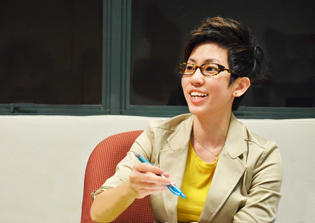Why Singapore’s English Teachers Should Embrace Singlish, Not Fight It
Is it time for Singaporean educators to embrace Singlish as a legitimate learning tool? What the Research […]
Read More
With the introduction of “Teach Less, Learn More” (TLLM) in 2005, many schools became interested in ground-up initiatives. As a TLLM prototype school, Tampines Primary School was at the frontier of this uncharted territory of school-based curriculum innovations. English teacher Donna Lim found herself in the thick of the action.
In 2005, then Principal Mrs Wong Bin Eng initiated a process that would enhance the way teaching and learning were carried out in Tampines Primary.
“She wanted to raise the level of teaching, so she identified teachers she felt would be good pillars of support for others,” recalls Donna, who was then Level Head for English and juggling a part-time Master’s.
Mrs Wong gathered a small group, comprising then Vice-Principal Mrs Sharon Siew and three teachers – including Donna – who were appointed “TLLM Activists”. The goal was to enable effective teaching and engaged learning.

The team quickly got down to thinking about what makes for effective teaching. They looked at the way classroom teaching was organized, across the whole school, and practices that engaged students in learning.
Working with fellow English teachers, Donna realized that many of them found it a challenge to teach writing. After some months of planning, they decided to try out parallel teaching.
This involved two teachers teaching the same class. Donna took over the lessons on writing while the regular English teacher reinforced these skills in their other lessons.
It was also an opportunity to learn from each other as the teacher observed how Donna taught, and then provided feedback for improvement. In this way, both teachers were engaged in continual learning.
“It was really a big structural change for us,” says Donna. “Where teachers used to progress in silos within the confines of their own classrooms, learning now extended beyond the immediate classroom.”
Central to the structural change was the use of PoETEL – Practices of Effective Teaching and Engaged Learning – an instrument developed by the school. This rubric is a result of a painstaking process of classroom observations.
They video-recorded, transcribed, analysed and reflected on the lessons, looking for practices that cut across all classes and subjects. This process sparked many discussions about what effective teaching and engaged learning look like.
“There were a lot of conversations,” recalls Donna. They talked with the school leaders, fellow colleagues, and even with external partners such as consultant Professor Colin J. Marsh and specialists from MOE’s Curriculum Planning and Development Division. “Just to come up with those few words in the rubric took many, many hours of talk!”
Eventually, they arrived at a repertoire of teaching practices. Each practice was broken down into four levels – novice to expert – and described in detail. The rubric was trialled in 2006 in tandem with the new structure, and refined further.
PoETEL was soon adopted across the school and is still in use today. While the rubric was designed primarily for observing classroom lessons, the teachers at Tampines Primary have also found it useful for lesson planning.
– Donna Lim, English Language and Literature Academic Group
PoETEL became a guiding structure for every teacher in the school as it served as “a guide for lesson planning and execution, a tool for lesson evaluation and a frame for professional development” (Tampines Primary School, 2009).
This process of thinking and talking is an important one for all teachers, says Donna. “It really made us think about what effective teaching and what engaged learning is. It’s really professional talk, and the rubric is the product of that.”
The school culture was a critical factor for change to occur. “All our teachers were very collaborative, very collegial. Because of that, we were very open with our sharing.” Many of them also took this as an opportunity to learn.
Donna credits a lot of the success to Principal Mrs Wong. “I think she was very revolutionary. Because my Principal was so for it, time was given to talking about it, and new structures were allowed to emerge. Time must be given to teachers; even time to just dialogue is important.”

Donna believes that a structure like this is useful for beginning teachers, especially those who teach English at the primary school level.
“The student teachers who come to us for our primary school programme are generalists. Very few of them have a relevant degree in English,” notes Donna. “I feel that a structure like what we had in our school worked because there was someone else there to guide you along.”
Besides teacher support, the structure created deliberate opportunities to learn from one another in an immediate and authentic scenario.
Looking back, Donna says this was one of the best journeys she’s had in her teaching career. “I really liked the fact that we went back to look at what teaching should be,” she says.
“It was scary but at the same time very fun because a lot of leeway was given in terms of freedom of curriculum, what you want to teach, the resources that you use. I think that, to a teacher, is very empowering and very exciting. I really enjoyed that a lot.”
Useful Resources
Goh, S. F., Lim, C.-T. D., Osman, N., Wong, B. E., & Boey, H. P. S. (2007, May). Impact of planning and application of PoETEL on students’ engaged learning. Proceedings of the Redesigning Pedagogy: Culture, Knowledge and Understanding Conference, Singapore. Retrieved from https://conference.nie.edu.sg/2007/paper/papers/INO506.pdf
Goh, S. F., Nonis, D., Lim, C.-T. D., & Wong, B. E. (2007, July). A school-based curriculum innovation: Practices of effective teaching and engaged learning. Paper presented at the Australian Curriculum Studies Association Conference, Melbourne, Australia.
Tampines Primary School. (2009). Practices of effective teaching and engaged learning (PoETEL). Singapore: Author.